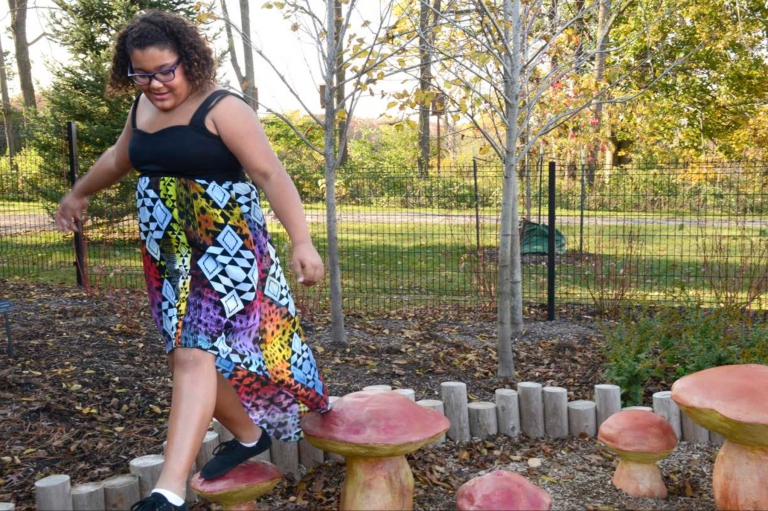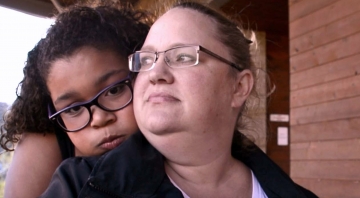Born identity
Schools are confronting the issue of transgender students and gender-nonconforming students at younger and younger ages
 Keegan Walker plays outside on an autumn day at the Penn State Arboretum on the University Park campus.
Keegan Walker plays outside on an autumn day at the Penn State Arboretum on the University Park campus.Photo by Lucie Couillard
Pink dresses adorn the Barbie aisle of Lovey Walker’s local Walmart.
For Walker, it is an area of the superstore that conjures memories. Years ago, it was where she first realized her 2-year-old son Keegan was meant to be her daughter.
She “wanted every doll, every dress,” Walker said, and she would “scream bloody murder” for princess dresses.
Walker, a single mother who lives in State College, Pennsylvania, bought a dress for Keegan, who would barely take it off. Keegan would go to preschool in boy’s clothing and, once back home, take off T-shirts and pants and put on a ballerina dress.
When Keegan was around the age of 2, Walker noticed that Keegan was different from her two older brothers. Keegan would dance around the house in her ballerina dress. She liked the television shows geared toward little girls, and she clung to the “princess stuff.”
Doctors told Walker that it was “just a phase” – something every boy goes through at some point. But, after a year of waiting and watching, the “phase” didn’t seem to end.
When Keegan was turning 3, Walker said, “the pediatrician was like, ‘You know what, I think it might be more than just a phase,’ so she went over transgender and identity disorders.”
A year after that, Walker and her other children began referring to Keegan, now 11, as a girl. They started calling Keegan “she” rather than “he.”
 During a recent interview, Keegan sat quietly at a gray-top table. She appeared distracted by the swivel motion of her chair, listening to her mother talk about this early time in her life but keeping her thoughts to herself. At the mention of the conversation with the pediatrician, however, Keegan interjected: “It’s not a disorder.”
During a recent interview, Keegan sat quietly at a gray-top table. She appeared distracted by the swivel motion of her chair, listening to her mother talk about this early time in her life but keeping her thoughts to herself. At the mention of the conversation with the pediatrician, however, Keegan interjected: “It’s not a disorder.”
In her free time, Keegan plays violin, a pastime her mother proudly confirms her skill in. She is a gymnast, a cheerleader and a dancer. She attends middle school, which she categorizes as filled with “drama.” Recently, Keegan has started wearing makeup – part of a routine to cover up any semblance of her former gender.
Her story is similar to those of other transgender and gender-non- conforming students in Pennsylvania.
Across the nation, an estimated 2 to 5 percent of people are “transgender” – a term that refers to people whose physical, sexual characteristics may not match their gender identity. That estimate also includes “gender nonconforming,” a term that can describe children whose behavior does not conform to gender expectations.
There is no breakdown, at this point, however, of what portion of that estimate are children or adolescents.
School districts across the country are confronting the issue of transgender students and gender-nonconforming students in the classroom at younger and younger ages.
In a report by the National Center for Transgender Equality, titled Peer Violence and Bullying Against
Transgender and Gender Nonconforming Youth, 6 percent of respondents who called themselves trans- gender or gender nonconforming in kindergarten through high school said they had been expelled from school for reasons related to their gender identity.
A person’s gender identity refers to the emotional and psychological sense of being male or female, according to the World Health Organization. It is different from a person’s sex, which, according to the WHO, refers to the biological and physiological characteristics that define men and women.
According to the 2011 National School Climate Survey conducted by the Gay, Lesbian and Straight Education Network (GLSEN), nine in 10 students regularly heard other students in their school make “negative remarks about how someone expressed their gender.” GLSEN said that two in 10 students are physically harassed based on the way they expressed their gender.
No statewide policy
In Pennsylvania there is no state-wide policy that deals directly with transgender students, said Shannon Powers, director of communications at the Pennsylvania Human Relations Commission. The com- mission is responsible for enforcing Pennsylvania’s anti-discrimination laws.
“When it comes to bullying and harassment, our school administrations range from involved and proactive to dissociative and neglectful,” said Victoria Martin, a student at West Chester University who is active in the Pennsylvania Student Equality Coalition. “One thing they all have in common: They are not compelled by a comprehensive state law to effectively prevent, report or remediate incidents of bullying and cyber bullying.” The coalition advocates on behalf of lesbian, gay, bisexual and transgender students.
School districts in the state have local control, which means policies are set by a locally elected school board, Powers said. And while state law says a school can’t discriminate, there is nothing specifically in place to protect students who are transgender or gender nonconforming.
Overall, Pennsylvania has been and continues to be a fairly conservative state, said Allison Subasic, director of the Lesbian, Gay, Bisexual, Transgender and Ally Student Resource Center at Penn State University. She teaches and supports students in the realm of higher education, but she and the organization also work closely with parents and children in the community on LGBT issues.
Pennsylvania is not well educated about lesbian, gay and bisexual issues in schools, Subasic said. In K-12 schools, things are changing for the better, but the transgender students seem like “a harder thing for people to grasp,” she said.
She said transgender children have a harder time in school than other students.
Powers said most schools take bias issues seriously. “Some schools do have training regarding gender and orientation differences among students. Some schools do a very good job of that. Other schools do not,” she said.
For Keegan, there has been a disconnect. This has created a journey that consisted of changing schools, moving among various communities in central Pennsylvania, look- ing for the right fit, her mother said.
Defining the difference
In 2006, when Keegan was first called transgender, the accepted term to classify it was “gender identity disorder.” Today it is called “gender dysphoria” by the Diagnostic and Statistical Manual of Mental Disorders (DSM), a guide to the classification of mental disorders created by the American Psychiatric Association.
The 2013 edition of the manual categorizes gender dysphoria in children as “a marked congruence between one’s experienced/expressed gender and assigned gender, of at least 6 months’ duration.” (The Merriam-Webster dictionary defines “dysphoria” as “a state of feeling unwell or unhappy,” the opposite of “euphoria.”)
According to the official journal of the American Academy of Pediatrics, clues indicating gender dysphoria in male children include a preference for female clothing and underwear, a desire for long hair, always sitting to urinate, and exclusive play with female toys when given a choice.
Clues in female children include a preference for male underwear, breast binding, refusal to wear female swimsuits, and “psychiatric decompensation” – the failure to create psychological coping mechanisms in response to stress – at the onset of menstruation.
Gender dysphoria in children that intensifies with the onset of puberty rarely subsides, according to experts.
Gender dysphoria can also refer to the desire to have playmates of the opposite gender, a rejection of masculine or feminine toys or activities, and a strong dislike of one’s anatomy. It can be a desire to have the primary or secondary sex characteristics that match one’s experienced gender, according to the American Psychiatric Association.
Josh Nicholas, a transgender student at Penn State’s Lehigh Valley campus near Allentown, said he didn’t have the words to express that he was transgender as a child, but he remembers that although he was born a girl, he identified with his G.I. Joe action figure. When he was 5 years old, he showed his mother his G.I. Joe and persuaded her to allow him to get his hair shaved. From there, he said, he “never looked back.”
Jessica Hertel, the Fort Lauderdale, Florida, author of “I Am Jazz,” a children’s book based on the story of a young transgender girl, said that since writing her book, she’s heard various stories about children who don’t identify with the sex they were given at birth.
In one such story, Hertel said, a mother entered the family’s bathroom to find her son with scissors, looking down and trying to cut off his penis.
“When the child is persistent, consistent, and insistent – this is when you need to focus,” Hertel said.
“Most of patients have an inkling that something is sort of different in early childhood,” said Dr. Rachel Levine, a professor of pediatrics and psychiatry and chief of The Division of Adolescent Medicine and Eating Disorders at Hershey Medical Center. This desire to change genders manifests in ages as early as 3 or 4, Levine said. Feelings al- most always get stronger in adolescence, when the body is changing in ways that the child doesn’t like, she said.
Hertel decided to write her children’s book one night after she had to explain to her own children what it meant to be a transgender child. That conversation took place when they walked into the room while a Barbara Walters special on the topic was being aired on television.
“I made the split-second decision to not chase them out of the room and see how much they understand,” she said.
Her children moved past it fairly quickly.
“The adult mind is focused on when will the surgery be and the hormones. I tried to explain it like, ‘This is a girl whose body got mixed up in her mom’s belly,’ ” Hertel said.
Transgender and gender-nonconforming children know better than adults, because they know who they feel they are. They don’t have all that “adult stuff” in their mind to cloud it, she said.
“Some children are very, very clear. You know, ‘I am a girl, I want to be a girl,’ but that’s not everyone,” Levine said.
A battle for acceptance
For Keegan, there were similar signs.
On one occasion, she asked her mother why she would call her a “boy” when, in her mind, she was born a girl.
“I’m like, ‘Well, ‘cause the doctor told me you were a boy,” Walker said. “But [Keegan] didn’t know that boy parts and girl parts were different. She just thought she was a girl.”
When Keegan was 4, the family decided to transition her from a boy to a girl before she began kindergarten.
That’s when they switched from “he,” “him” and “brother” to “she,” “her” and “sister” – to using “girl.”
But it has been difficult, Walker said, acknowledging that she had to “reprogram” her brain.
Often how easily a child transitions is based on the acceptance of one’s parents or school, said Rachel Levine, the pediatrician. For many transgender or gender-nonconforming children, problems often arise in school.
“If you’re just going through life and every single person you meet constantly calls you by the wrong name, it gets beyond annoying, it becomes dehumanizing in a way,” said Victoria Martin, the West Chester University student. “It’s really harmful, especially when you have students who are coming out at earlier and earlier ages. If a school doesn’t respect them, then that is an entire adolescence of having their identity un-affirmed.”
In some instances, if the child is an extreme tomboy or a feminine boy, then sometimes others don’t recognize the person is transgender, Levine said.
Others will try to change the child.
“Some people can be really cruel and they think that they are going to make the person better, but what they are really doing is hurting the young person,” said Allison Subasic of the student resource center at Penn State.
From Levine’s standpoint there’s “nothing medical to do,” because it’s hard to tell who’s going to be gay, transgender or “just different” at such an age, when the child doesn’t have any active sex hormones.
So, when children challenge their gender identity, the right course of action is to “try not to force them one way or other,” Levine said. There are a few kids who basically transition themselves, she said, and it’s important for others to follow the child’s lead.
In Pennsylvania, there are no laws that require school staff and administration to respect students’ gender identity, pronouns or preferred names, or to allow them access to spaces like bathrooms that match their gender identities, Martin said.
Issues persist, Subasic said: being called by names they would not like to be called, not letting them dress the way they would like to be dressed, and letting them be ridiculed by others – students or adults.
“You’re not going to change who a person is,” Subasic said. “You’re not going to make them straight, you’re not going to make them cisgendered, which is being born as a female and identifying as a female.”
Hertel said elementary schools often direct nonconforming students to use the nurse’s bathroom. “It’s traumatizing,” she said. “That’s where kids go to throw up.”
Hertel said that often prompts these children to avoid the bathroom all day, and they end up getting sicknesses or infections.
To “not cause problems,” Keegan used the nurse’s bathroom during elementary school. “Everybody kept asking, ‘Why do I use the nurse’s office?’ ” she said.
In elementary school, Walker said the school at first made it seem that if Keegan went into the girls’ bathroom, she was going to be looking at other girls, or someone would try to look at her. She said people often immediately associate the idea of using a bathroom with something sexual.
“Even when she was, like, 8 or 9, people would say, ‘Well, does she like boys or girls?’ her mother said. “It’s like, she’s 8, or she’s 7, and I think people’s minds automatically go that way.”
Walker said she could have fought the school district on the bathroom issue, but she said that for Keegan’s safety, she was OK with her using the nurse’s bathroom.
Few districts have policies
In Pennsylvania’s public schools, five public school districts out of 500 offer protection for transgender students in their nondiscrimination statements, Martin said.
These districts are State College Area, Pittsburgh, New Hope-Solebury in Bucks County, Allentown, and Abington in Montgomery County.
The districts that have nondiscrimination policies “and might be a little more welcoming” tend to be located in highly educated areas or in big cities, Subasic said.
Martin said transgender students are at the mercy of their school administrators or teachers. “The administration is almost always the last word on whether or not a student’s gender identity is accepted,” she said.
In the five districts that have policies to protect transgender students, a student who is discriminated against can appeal to the next level of administration. In school districts without those policies, the only recourse is litigation, Martin said.
For Keegan, her kindergarten teachers said they were fine with saying Keegan was a girl, but their actions didn’t always match, Walker said.
On the first day of school, Keegan arrived dressed as a girl. But when students lined up for the bathroom, her teachers moved her from the “girl line” and placed her in the “boy line,” Walker said. When her teacher organized a Christmas gift exchange, in which each girl in the class had to bring a gift for another girl, and each boy for another boy, Keegan brought a girl gift. The teacher, however, had bought a boy gift and gave it to Keegan to take home as her exchange, Walker said.
Striving for specifics
In late April, the U.S. Department of Education announced that Title IX, the law that prohibits sex discrimination in schools, protects transgender students from discrimination.
For Martin, the announcement was flawed because it was vague. What she wants is “a bold declaration, you know, like, ‘Trans students can use whatever bathroom they want to use.’ ”
For transgender students, pursuing remedies under Title IX can become so complicated that they have to hire lawyers. “You’re going to have to sue the school district essentially for violating the provisions of the federal government, and that is an insane, huge under- taking, and that could take years,” Martin said.
Solving such problems, Subasic said, will be an uphill climb. “I think it’s going to take parents who have children who are trans, really pushing for the rights for their children to have a safe place to go to school,” she said.
Children are more likely to be well adjusted if they are able to transition at a young age, Subasic said. “You need to let people be who they are,” she said. “Why in society are we so stuck on the dichotomy of male and female, boy and girl?”
Walker said others in the community have summoned Child Youth Services to her home three times. “Three times, for ‘forcing’ my son to wear girls’ clothes,” she said.
When Keegan was young, people would say to Walker that she must have forced Keegan into being a girl – that she wanted a girl because she already had two boys.
“It absolutely couldn’t be any further from the truth,” Walker said. “That’s the misconception. ... They think, ‘How can you do that? Just make her be a boy.’ Make her. And I’m like, ‘It’s not that easy,’ and I wouldn’t want her to live her life not being who she wants to be.”
Keegan and her mother said they had encountered other aspects of discrimination.
For example, when Keegan joined cheerleading class at age 8, she was asked to wear shorts. All the other girls were allowed to wear skirts.
When Walker had turned in the paperwork for cheerleading, she had covered up the gender identification on Keegan’s birth certificate. Other parents didn’t want Keegan to be allowed to wear a skirt. At that point Walker told the president of the organization, “You can’t make her wear shorts when she identifies herself as a female.” Keegan eventually was allowed to wear a skirt.
A few years ago, a child from her middle school yelled at Keegan’s window, “making comments, like, ‘Do you have a penis?’ Screaming up at her window,” Walker said. Walker called the boy’s mother. “I said, ‘Your son’s screaming stuff to my daughter,’ ” she said. “And they’re like, ‘Well, he says it’s really a boy,’ and I’m like, ‘Really, is that any of your concern?’ ” Walker said Keegan’s reception by others is getting better. “Five years ago or even two years ago, people really didn’t understand,” Walker said. “I mean, they still don’t. A lot of people still don’t, ... but it’s more common, if ‘common’ will ever be a term for transgender youth.”
The classroom climate
Advocates say there are many things school officials should do to help these children.
Subasic said, “Start with policies and procedures, and the restrooms, and then start working on the training.” Since all teachers have in-service days for training, she suggested, schools should devote time to helping them learn about the LGBT community.
Dr. Wesley Shipley, superintendent at the 4,554-student Shaler Area School District near Pitts- burgh, said “we believe in nondiscrimination based on anything,” so he opposed focusing nondiscrimination training on LGBT issues.
“Rather than to narrowly define our policy to include small groups or any one particular group, we use these broader groups,” he said. “‘Sexual orientation’ is an umbrella word that takes all those in.”
Shipley said teachers are aware of the nondiscrimination policy and that guidance counselors and social workers can seek out additional training on specific social issues.
States that have transgender-explicit nondiscrimination laws are California, Colorado, Connecticut, Hawaii, Illinois, Iowa, Maine, Massachusetts, Minnesota, Nevada, New Jersey, New Mexico, Oregon, Rhode Island, Vermont and Washington, as well as the District of Columbia, according to the Trans- gender Law and Policy Institute.
In August of this year, California Gov. Jerry Brown signed into law the School Success and Opportunity Act, giving transgender students legal rights to full access of school facilities and sports programs. The law requires California schools to allow transgender and gender-non-conforming youth to use bathrooms and locker rooms that match their gender identity. It is a first of its kind in the United States.
In Pennsylvania, Martin and the Pennsylvania Student Equality Coalition are pushing for policy changes.
“One of our biggest roles for quite a while has been promoting the Pennsylvania Safe Schools Act, which is trying to update Pennsylvania’s bullying code,” she said. “Right now, what we have as law in Pennsylvania is very vague: ‘Do not bully.’ Every school district needs to have their own bullying policy, but it doesn’t say what needs to be in it.”
Jessica Hertel has been trying to make changes by placing books about transgender students on the library shelves of various schools. Already she has met representatives from what she considers the 30 most progressive school districts in the country. “There is no natural model on how to teach LGBT inclusion,” she said, and some schools are “teaching by trial and error.”
Inspiring confidence
For Walker, Keegan’s transitioning was initially like losing a child. There was “a mourning period,” she said, and she would gaze at photos of Keegan as a baby boy. But she quickly decided that she gained a new child the day she switched Keegan’s pronouns – a child who describes herself today as “beautiful” and “fierce.”
Although Walker said she will worry about Keegan until the day she graduates, she said Keegan is confident in herself and her female gender.
She’s been a girl for as long as she can remember.








